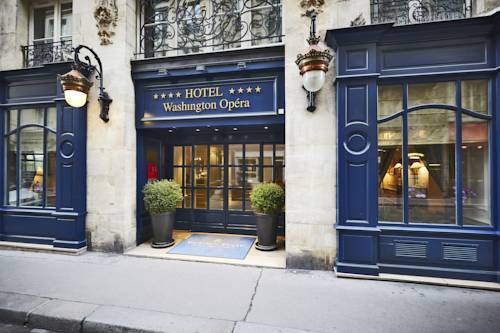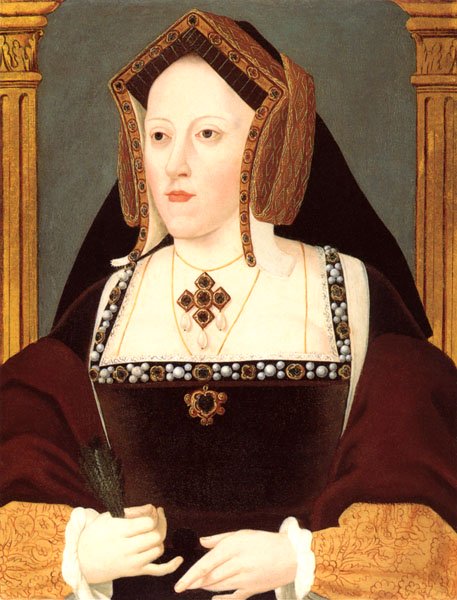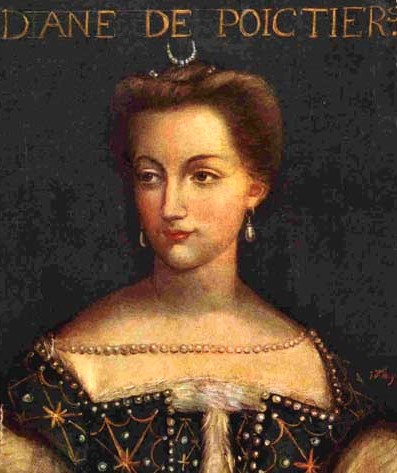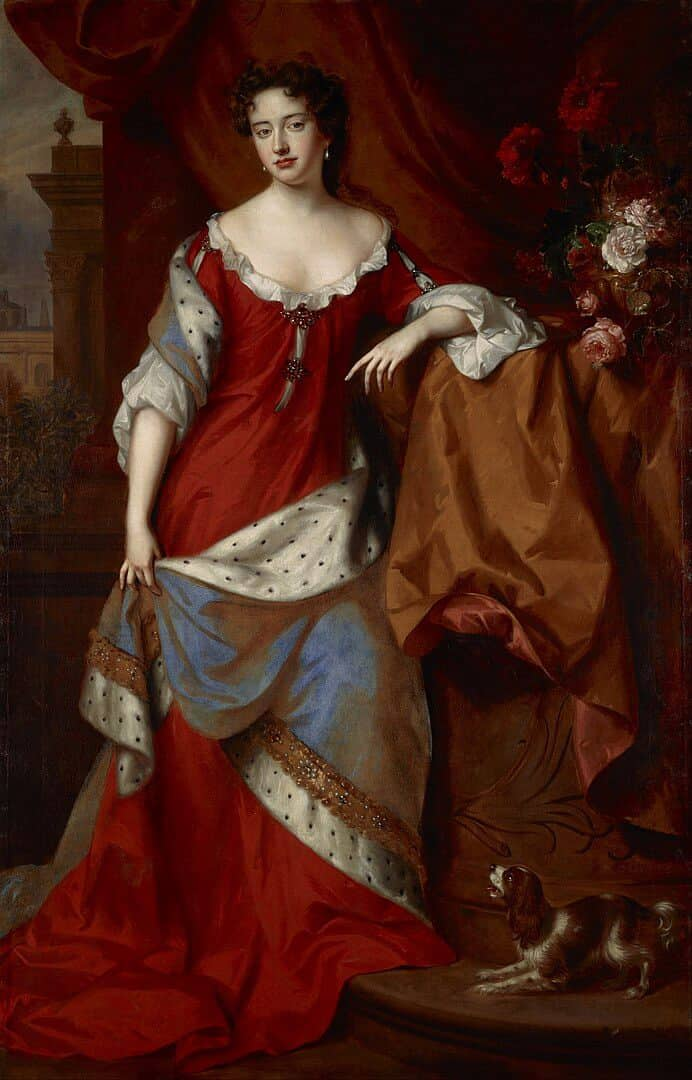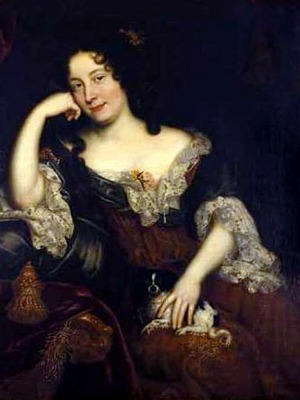Madame de Pompadour
Jeanne-Antoinette Poisson, Marquise de Pompadour (29 December 1721 – 15 April 1764), commonly known as Madame de Pompadour, was a member of the French court. She was the official chief mistress of King Louis XV from 1745 to 1751, and remained influential as court favourite until her death.
DISCLOSURE: I get commissions for purchases made through some of the links in this article.
madame de pompadour's real name: Jeanne-Antoinette Poisson
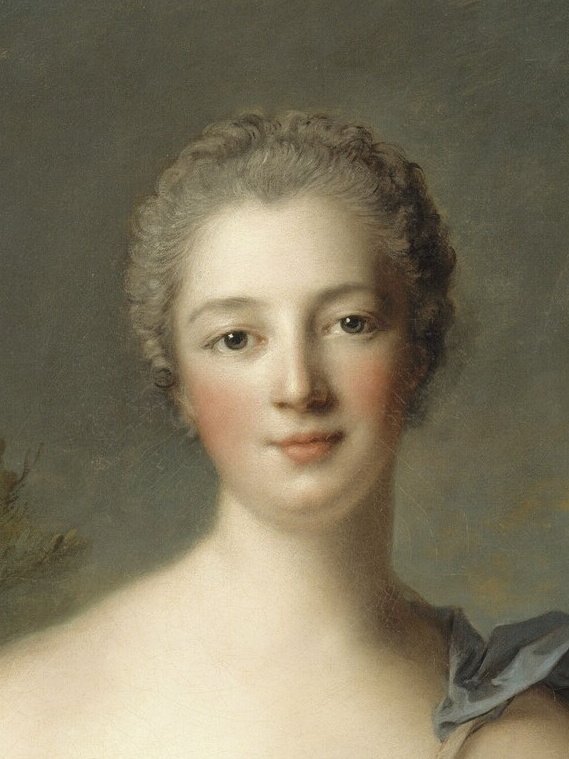 Madame de Pompadour (1722–1764), the mistress of Louis XV, represented as Diana the Huntress, by Jean-Marc Nattier
Madame de Pompadour (1722–1764), the mistress of Louis XV, represented as Diana the Huntress, by Jean-Marc NattierMadame de Pompadour is born as Jeanne-Antoinette Poisson on December 29, 1721. She grows up in the affluent circles of Paris where she is popular and loved.
Jeanne-Antoinette's father François La Motte Poissonhas has to flee the country in 1725, following a scandal over some unpaid debts. Her mother has to raise Jeanne-Antoinette and her brother alone. Charles François Paul Le Normant de Tournehem, the local férmier général (tax collector) becomes the legal guardian of the children. The rumour goes that he is their biological father.
Thru or not, he makes it possible for Jeanne-Antoinette to get a good education. That is, a good education for a royal-mistresses-to-be. She learns how to act, dance, sing, paint, engrave and play the clavichord.
She gets married on the age of 19th to Charles-Guillaume Le Normant d'Étiolles, a nephew of Tournehem. They have a daughter together, Alexandrine-Jeanne. The marriage was not happy, and they separated in 1745.
Her non-noble birth does not keep her guardian de Tournehem from his plan to bring her to the attention of King Louis XV. Together with the bankers of Pâris, Cardinal de Tencin and Marshal Richelieu, he works out his plan, hoping that Jeanne will become the new official mistress. That way they can influence the King through her.
King Louis XV has been married to Queen Maria Leszczyńska for 10 years by then. In those 10 years, she has given birth to 10 children. She has made it crystal clear to the King; as far as she is concerned, that’s enough! She denies him access to her bed, the only form of contraception that there was at that time!
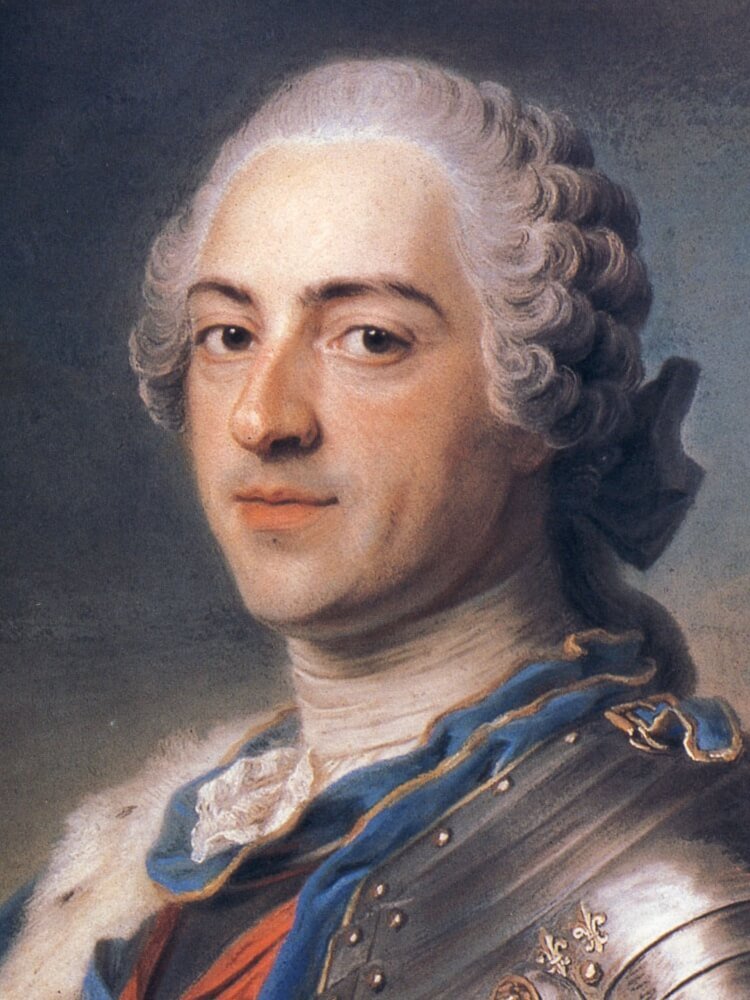 King Louis XV in 1748, by Maurice-Quentin de La Tour
King Louis XV in 1748, by Maurice-Quentin de La Tour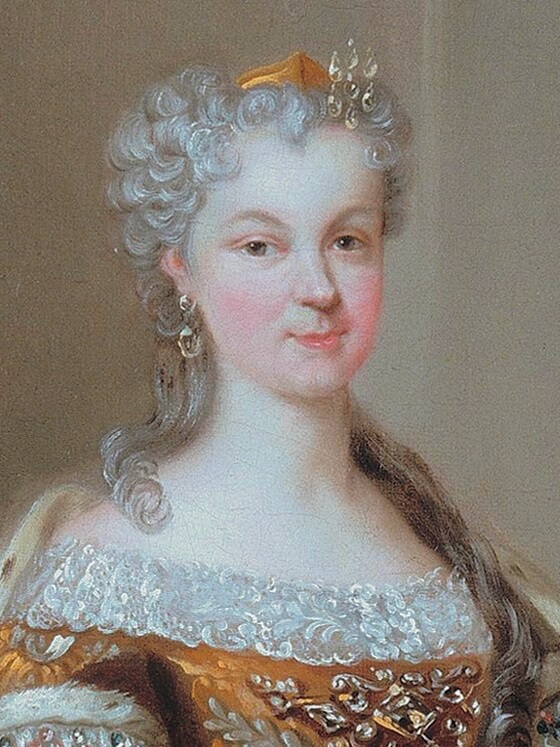 Queen Maria Leszczyńska, the wife of Louis XV
Queen Maria Leszczyńska, the wife of Louis XVmadame de pompadour books
As an Amazon Associate I earn from qualifying purchases
madame de pompadour and louis xv
King Louis XV has no lack of female attention and enough mistresses, including four or the five daughters of Louis de Mailly, Marquis de Nesle. The function of maitresse-en-titre is vacant at that time.
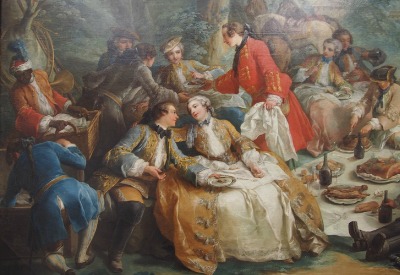 King Louis XV with three of the four Nesle Sisters he had an affair with. He is talking to Pauline Nesle, her sisters Diana and Louise are watching the couple closely!
King Louis XV with three of the four Nesle Sisters he had an affair with. He is talking to Pauline Nesle, her sisters Diana and Louise are watching the couple closely!The bankers' plan was a smash hit. On the 25th of Feb, 1745, Jeanne and the king locked eyes at a masked ball in Versailles. The king was smitten, and within the month, Jeanne was living in the apartment one floor above him at the palace of Versailles. Her rooms were above the Mars, Mercury and Apollo Rooms in his privat appartments, so the king was able to easily access her without having to go through the public areas of the palace.
There is a problem though. Jeanne is not of noble descent and consequently cannot be officially presented at court, nor hold the function of Maitresse-en-Titre. He can not keep her locked in te atttick forever, so she must be uplifted.
Of course, for a King in those days, this is not a major problem. Louis buys the title Marquise De Pompadour, a noble title that was conveniently vacant at the time. Jeanne receives not only the title, but also the castle that goes with it. The Chateau de Pompadour is the first of many houses and castles that she would collect during her career.
Marquise de Pompadour, Royal mistress to King Louis XV
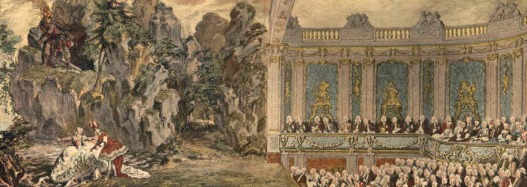 Madame de Pompadour performing at the theatre built on the Ambassador's Stairs in Versailles
Madame de Pompadour performing at the theatre built on the Ambassador's Stairs in VersaillesNow there are no more restrictions for Jeanne, Marquise de Pompadour, to move into the spacious apartments at Versailles that are reserved for the Maitresse-en-Titre.
The only downside to her story is her realation with the other courtiers. They openly ventilate their disapproval. A commoner at Court, they had never experienced that before! The conservative, to Royal protocol addicted courtiers, call her names and whisper behind her back. Some of them oppose her until her death.
Antique Sevres Porcelain on Ebay
Madame de Pompadour ignores these people and soon becomes indispensable to the King.
The King, who had mainly amused himself with hunting game and women, now becomes interested in other matters, inspired by Jeanne.
She starts to ramp up theatre plays, in which she and some friends play the lead roles. The little theatre where these performances take place only has a place for 14 people. Later she gets more space and there may be around 40 people able to see the play.
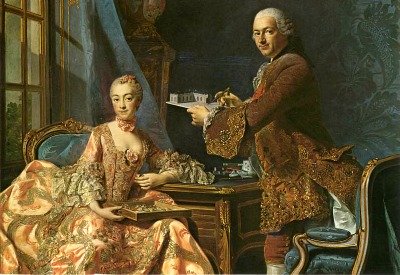 Marquise de Pompadour and her brother Marquis de Marigny by Roslin 1754
Marquise de Pompadour and her brother Marquis de Marigny by Roslin 1754Of course, the courtiers load actresses as much as commoners. Still, everyone at Versailles palace wants to witness these performances. They beg for an invitation to Jeanne's plays, suppers and parties. This is the best way to have access to the King.
The petit suppers of the Madame de Pompadour are soon famous. She decorates the tables and rooms with flowers of Sèvres porcelain, and chalices full with olfactory waters from Grasse. She is intelligent and well-read, among her friends and protégés she can count Denis Diderot and Voltaire.
The attitude of many courtiers turns. They try to reconcile with the Marquise de Pompadour, only to get invited to her performances and diners. She keeps having enemies at court though.
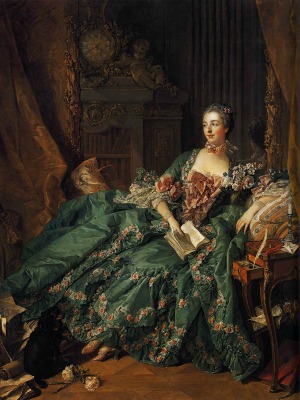 Madame de Pompadour in 1756, by Francois Boucher
Madame de Pompadour in 1756, by Francois BoucherJeanne sends her brother, Abel-François, Marquis de Marigny, who has no political aspirations, to Italy to study art. Together they become great protectors of art and science in France.
The Marquise de Pompadour is crazy about porcelain. Under her influence, the famous porcelain factory from Vincennes is moved to Sevres in 1756, and given the ' Royal ' status. The place is not picked entirely random. Madame also owns a castle here; the Chateau Bellevue.
The King takes over the management of the company. In fact, the factory management lies with Madame de Pompadour. In the factory buildings, special apartments are reserved for the King. Madame de Pompadour proclaims that whoever does not buy Sèvres porcelain is no French patriot...
With Madame de Pompadour's backing, Sèvres experimented with glazes, shapes, and techniques. This led to the development of the iconic "rose Pompadour" color, a vibrant pink named in her honor.
Her association with Sèvres transformed it into a coveted luxury brand. European nobility clamored to own Sèvres pieces, making them a symbol of wealth and sophistication.
Houses and Castles of Madame de Pompadour
The King and his mistress spend hours together planning purchases, remodellling and decorating countless houses and castles. Madame de Pompadour surrounds herself with beautiful stuff, her rooms are jammed.
Chateau the Pompadour
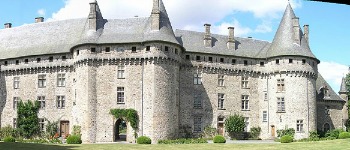 Chateau de Pompadour
Chateau de PompadourThe first property that Jeanne owns is the castle of Pompadour, South of Limoges. The fun part of this is, she's never been there herself!
The Castle was merely a byproduct to the title of Marquese the Pompadour that she received from the king. The Chateau the Pompadour now houses one of the best riding schools in the world. You can also go horseback riding yourself. The castle is open for visits.
The hermitage at Versailles
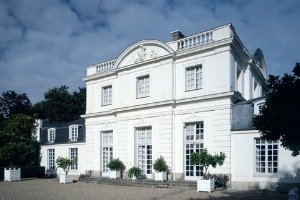 The Hermitage opposite the Chateau de Fountaineblue
The Hermitage opposite the Chateau de FountaineblueIf you have some money to spend; the Hermitage opposite of the Chateau de Fountaineblue is for sale!
The hermitage at Versailles was for Madame the Pompadour what the petit Trianon was for Queen Marie Antoinette some years later. An idyllic, quiet and rural one-story building where she and the King could retire from the busy and demanding court life.
Jeanne kept chickens, goats and a donkey. The Pavilion was surrounded by a beautiful garden. The decor was simple but tasteful.
The success of the hermitage is demonstrated by the fact that soon two more of such houses were built. The first in Compiegne (unfortunately completely destroyed) and another opposite the chateau de Fountaineblue.
This last one is still intact and in 2011 it was for sale for USD 9.3 million.
The King used to leave Fountaineblue in his hunting clothes like he was going hunting, and then sneaked to the hermitage and spend the whole day with the Marquise!
Château de Choisy
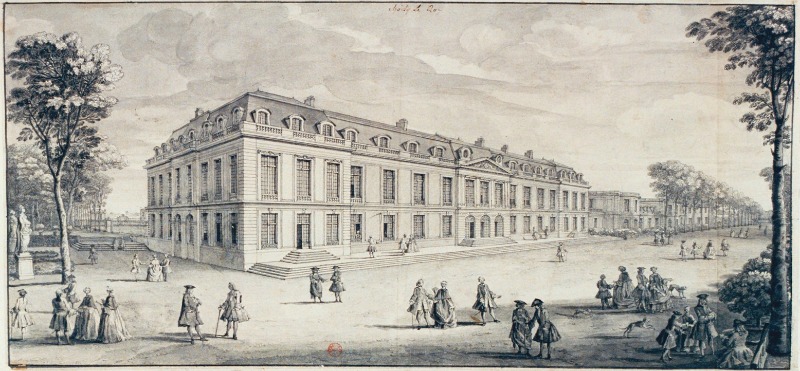 Château de Choisy
Château de ChoisyChâteau de Choisy was a gift from Louis XV to madame the Pompadour in 1746. This castle was nationalised during the French Revolution, and since then demolished bit by bit.
Château de la Muette
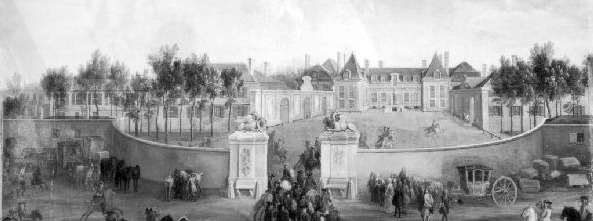 Château de la Muette
Château de la MuetteThere have been three palaces on these grounds. The second one inhabited by, among others, Madame de Pompadour. This second castle was demolished in 1793. A new castle was built on the estate in 1921.
Château de Bellevue
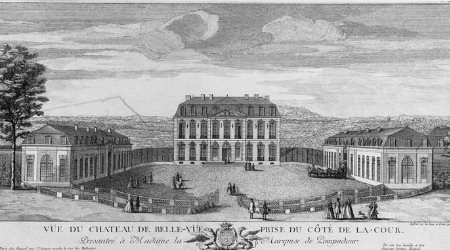 Château de Bellevue
Château de BellevueChâteau de Bellevue was a small castle commissioned by Madame de Pompadour and built by her architect Lassurance. Unfortunately, it was looted after the French Revolution, and completely demolished in 1823.
Château de Champs-sur-Marne
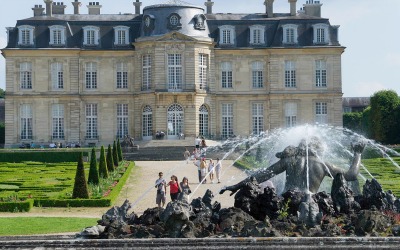 Château de Champs
Château de ChampsChâteau de Champs-sur-Marne, near Paris, was hired by de Pompadour from the duc de La Vallière. She spent 200,000 livres in 18 months to redecorate it. She left it then because the King did not like it there. You can read more about this palace if you click here.
The Élysée Palace
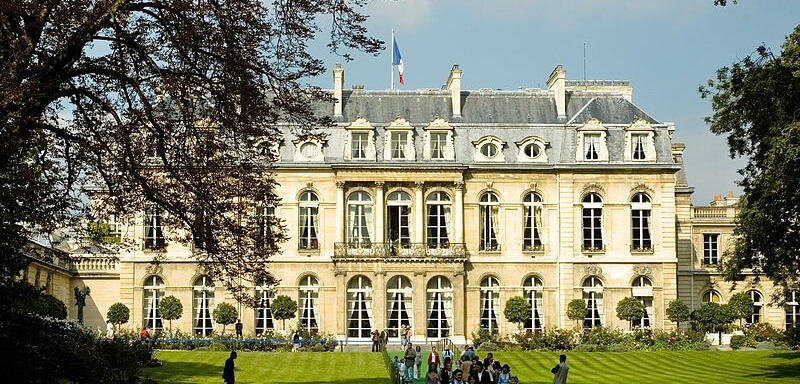 The Élysée Palace
The Élysée PalaceThe Élysée Palace, nowadays the official residence of the president of the French Republic, was Jeanne’s house in Paris. She had her favourite architect, Lassurance, make some adjustments and changed the gardens.
You can visit the palace only on European Heritage Day, but you can make a virtual tour on the website of the Élysée Palace.
Or take this exclusive tour inside the Élysée with France 24:
The Château de Menars
 Château de Menars
Château de MenarsMadame de Pompadour bought this palace in the Loire Valley at the end of her life, she's been there only twice. After her death, she left it to her brother and he went to live there with his wife Shahin Marie Françoise Filleul (the illegitimate daughter of Louis XV and Irène du Buisson de Longpré!).
Nowadays this castle is the only one that is 100 % privately owned by a philanthropist who painstakingly restored it. It took him three decades and more than $100 million. Upon request the chateau sometimes welcomes visitors.
The Petit Trianon
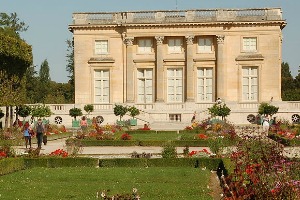 The Petit Trianon
The Petit TrianonThe Petit Trianon was the last building that has been added to the park of Versailles. This was a joint project of the Marquise de Pompadour and the King. The construction phase lasted from 1762-1768. Unfortunately, Madame de Pompadour already died before it was ready. She did never use this small Palace in Greek style herself. Queen Marie-Antoinette would use it often to escape the crowds at Chateau de Versailles.
Hotel Washington Opera
|
Hotel Washington Opera was once the townhouse of Madame de Pompadour. Nowadays, the building is a romantic 4-star hotel in the heart of Paris. |
Traces of Madame de Pompadour
Jeanne Poission remained the King's first mistress until her death in 1765. She died of tuberculosis after almost 20 years at court, she was only 43 years old.
The common belief is that during the last years of her life she had no more sexual relations with the King. Still, she was his most loyal friend and counsellor; that must have been true love!
The French population did not love her that much at the end of her life. , They held her responsible for the seven-years' war that made France virtually bankrupt. After her death, she was buried in the Church at the place du Vendôme. Her daughter Alexandrine was also buried there after she died in 1754 at the age of 9. This church, like most of her homes, is gone nowadays.
Most of the extensive legacy of Madame de Pompadour went to her brother Abel, Marquis de Marigny. He decided to sell most of the items. This sale began in April 1766 and would last one year. Interested people could see the collection in Paris, and there were many interested people. Everyone wanted to gaze at the excessive wealth that the Maitresse-en-Titre gathered during her life. Most visitors could not afford to buy anything.
Thus began the spread of the Marquise’s collection of artefacts, books, furniture, ceramics, etc.
Abel kept a lot of the paintings that portrayed his sister for himself. He found the painting by van Loo showing the best resemblance with the real Jeane. The painting shows madame de Pompadour dresses as Turkish harem women.
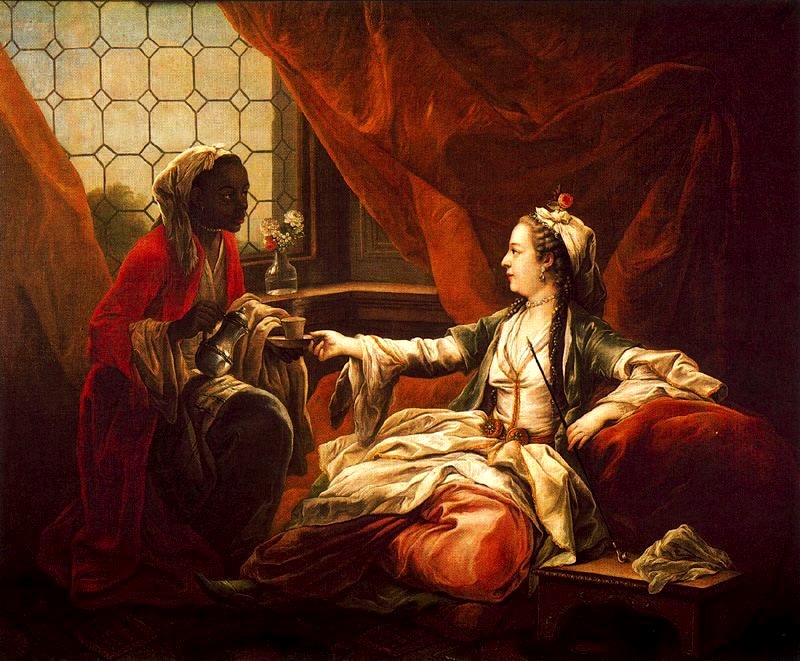 Madame de Pompadour as Sultana Taking Coffee, painting by van Loo
Madame de Pompadour as Sultana Taking Coffee, painting by van LooIn order to find traces of Madame de Pompadour, a visit to the Louvre Museum in Paris is a good start. Here you will find the original paintings by Boucher, de la Tour and Nattier. Also, some furniture with her coat of arms can be found here among other works of art.
The Petit Trianon was originally designed for Madame de Pompadour. Because she died before it was finished nowadays it is mainly associated with Marie Antoinette.
There are no traces of her there, and you won’t find any in the state Apartments of the Palace of Versailles either. You will have to take a guided tour around the Petit Apartments to find a trace of her. at Versailles Palace. Only this special guided tour leads you into the private rooms of the royal family and the "The King's mistresses' apartments".
Unfortunately, many of the houses of the pompadour don’t exist anymore. The exception is the Chateau de Champs in Seine-et-Marne. This castle is still there and can be visited. For more information visit the website.
Also the Château de Menars still stands on the banks of the Loire, but is privately owned and not open for visitors.
Many pieces from the collection of the Pompadour can be found in Great Britain. For example, in the Victoria and Albert museum, the National Gallery in Edingburgh and in the Wallace Collection art and items of Madame the Pompadour can be found.
Madame de Pompadour in Books:
As an Amazon Associate I earn from qualifying purchases



